When watching action sports media, many viewers react along the lines of“how do you even do that?” But even in the most extreme cases of skiing, biking, or surfing, there’s some understanding of what’s required mechanically. For example, not everyone who learns how to ski learns how to do a backflip, but most people know how to make a turn. Often there’s a baseline understanding of what we’re watching, even if it’s on a different level from the viewer. However, whitewater kayaking has a harder time making these connections to the general population. While bits of whitewater kayaking have made themselves into mainstream media, like the videos of Dane Jackson that populate social media, they are usually captioned with something like “crazy kayaker runs insane waterfall,” and in some ways it takes the accessibility out of the sport. Whitewater kayaking is a very small sport-- a 2019 study reported that only 7 percent of whitewater kayakers spend more than twenty days on the river per year. If you compare this number to sports like skiing and how many days a year it takes to be proficient if not an expert in the sport, that’s a pretty small percentage of paddlers that would be considered experts. But whitewater kayaking has created its own little niche in action sport world and even within that, running big, and we’re talking big drops, is its own speciality.
The Pacific Northwest has been time honored as one of the world’s great hubs of big, runnable waterfalls. It joins the likes of Mexico and Norway with falls like Outlet, Palouse, Celestial, Metlako and more as crown jewels of waterfall running. The two drops on Rattlesnake Creek were the last two unrun drops of the Northwest until a historic flood event hit the Columbia River Gorge in January of 2021 bringing perfect flows for the drop. Rattlesnake Creek features two back-to-back 90-ish footers that require massive volumes of water. Galen Volckhausen completed the first descent in January with Hayden Vorhees, who also ran the second of the two. Following the second and third ever descents of the 189-foot Palouse falls a couple of years prior, the number of unrun drops in the Northwest dwindles. But the descent of Rattlesnake demands respect on its own.

We talk a lot about avalanche and snow safety here at Teton Gravity Research, but very little does the mainstream sports media talk about whitewater safety. If you’ve ever been on a commercial rafting trip, your guide has probably told you things like “don’t stand up in the river” and “keep your feet up in the water.” But whitewater kayaking, let alone running drops like Rattlesnake, is a whole different animal. We wanted to hear more about everything that goes into running a drop like this in order to make the content a little more accessible to the public and also because, let’s be real, it’s super cool. Lucky enough for us, we got to sit down with our own local expert- Jackson Hole Kayak Club’s Executive Director Reed Hutton- to chat about running big drops safely, the factors that go into it, and the implications of these massive PNW drops. Reed has been paddling for the better part of his life, and now plays a key role in bringing up paddlers in the Jackson Hole area. This role as a coach, not only of basic and advanced paddling skills, but also of decision making make him just about the perfect person to chat with about how others wind up running drops like this.
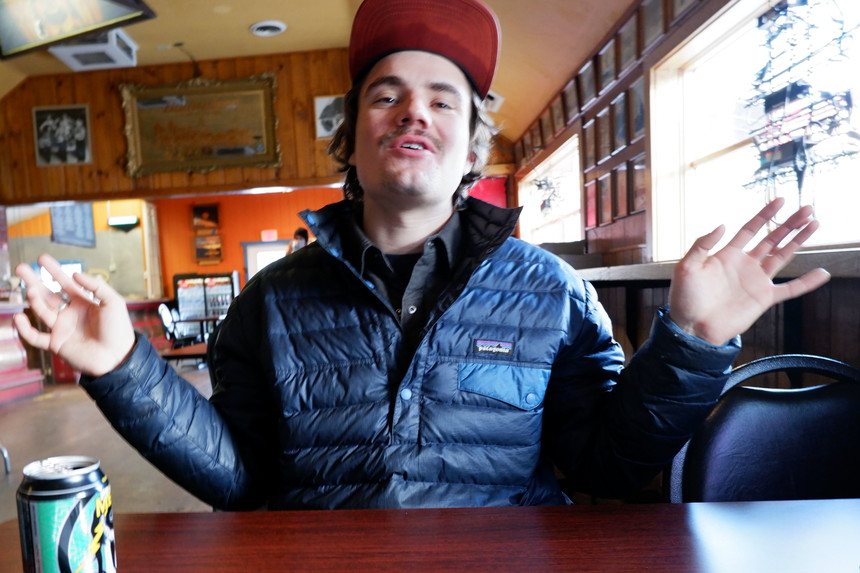 Reed probably telling me how sick something is. Izzy Lidsky photo.
Reed probably telling me how sick something is. Izzy Lidsky photo.
Bear with us here-- oftentimes when two paddlers get to chatting it tends to sound like a different language, but we’ll put a little glossary in for you to refer to.
How long have you been paddling exactly?
Reed Hutton: I’ve been paddling since I was ten, so thirteen years.
Can you talk a little about your progression and styles of boating?
RH: So, I grew up in the Jackson Hole Kayak Club. It’s a summer youth kayaking program based in Jackson Hole, Wyoming. It’s accessible for all ages, all genders, and kids in the Jackson area to come explore the rivers of the greater Yellowstone ecosystem. It was an awesome way to get on the water with friends and have coaches as really solid role models and I grew up in a river family, so every summer my parents were focused on chill river trips and fishing and stuff. But we were constantly spending time on the water and over and over I fell in love with it. I was lucky enough to grow up on the Snake which is super deep Class III and fun playboating. There’s so much access to other cool rivers, and I grew into creeking and river running.
Would you say you’re pretty evenly balanced in terms of creeking and playboating experience?
RH: I’ve never really tried to quantify them, to be honest. Are we talking about skill or how much fun I’m having? They’re two different beasts and there’s a lot to be said about both. There’s a lot more to be said about someone’s approach to kayaking and their approach to safety and what it means to be on the river as a testament to their skill than if they can do a bow stall.
As a kayak coach can you talk about stepping up on the water, both in terms of decision making and skills?
RH: I think with coaching, it starts with a comfort with your craft and an ability to do the basics and be able to teach them. For me, it’s stepping into that role and knowing I want to do it, and trying to do a really good job. Part of that is relearning everything I’ve learned how to do in order to make it palatable to someone else. I get a lot of joy doing that, seeing kids realize a concept that I’m trying to teach them-- whether it’s like rolling or an eddy turn, or if it’s like dropping a big rapid. I think all the best coaches have the best attitude towards coaching and want to grow the sport. As for safety and everything, coaching is essentially like paddling with any other group you would, but understand that at the end of the day you are the final decision maker. You can talk people through a rapid-- the risks, the consequences, the lines. Being able to have a clear head, understand the risks, the objectives, the skills, are all part of being a good river runner in general.
How do those things translate into your own paddling?
RH: When I’m paddling for fun, I’m paddling with friends or people I’ve done it with for so long so there’s a lot of communication that doesn’t happen and a lot of expectation around where we’re going and what we wanna do. There are days where we’re lazy and hungover and wanna go paddle to Astoria with no spray skirts or days where we’re really eager and dialed in and want to go push ourselves and drop the big rapids or make a mission out of it.
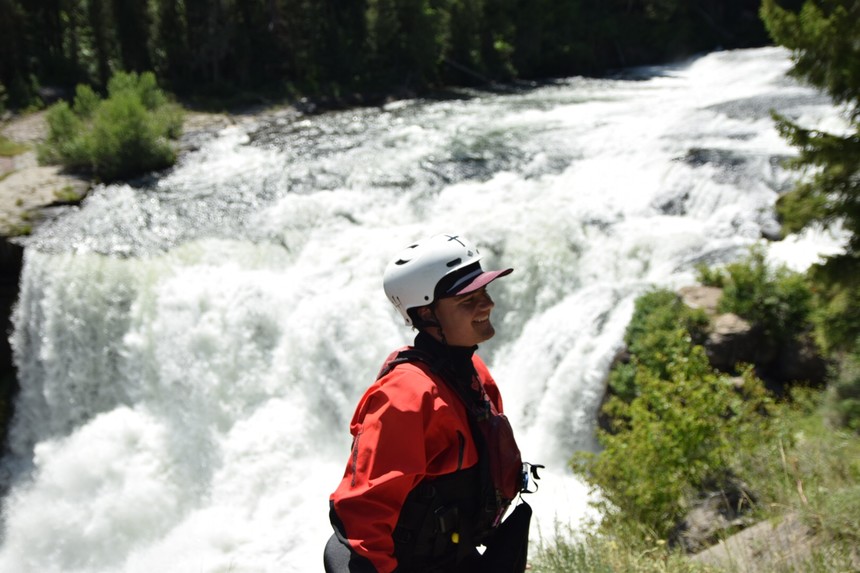
What are some of the bigger drops you’ve run?
RH: The first real drop I ran was on Fall Creek which is a tributary of the Snake, south of Hoback. That’s like five or ten feet, I did it with a friend and that was my first taste of freefall. Then I went and did middle and lower Mesa Falls. Middle Mesa’s like a perfect ten foot boof and lower Mesa’s a double drop-- I walked the first drop, it’s like a fifty foot cascade, and the bottom drop’s around thirty feet. Those are kind of the two in this area where it’s like a badge of honor for paddlers to have done them. Not so much Fall Creek, but Mesa for sure. It is kind of like a right of passage sort of thing. I could get into the safety of it…
We’ve talked about running Mesa before, but go ahead and get into it.
There’s a lot of issues with running Mesa because whenever you’re running a waterfall, you’re dealing with a high level of risk, obviously. That’s one that the Kayak Club doesn’t really want to take. But a lot of kids will graduate from the Kayak Club and go run it themselves, or find a buddy with a car so there’s kind of this idea in my head, now that I’m the director of preparing kids. I know they’re gonna do it as soon as they graduate cause they’re good enough to do it, and they understand water enough to paddle it. But it’s the safety and decision making side of it.
I ran lower Mesa, ran middle Mesa. I went to college in Vermont, and there was a fifteen footer like in the town of the college I went to. I would just lap it all the time. It was so fun, the perfect boof, I could add it into a flat water workout. There was another twenty footer close to campus on the New Haven Ledges called Toaster Falls, it was awesome. Like a super sweet kind of lead in, pretty fast, to a stout twenty-footer. I ran another twenty-footer in Chile on the Upper Palguin. I did Steelhead falls, did a freewheel off that one. Then Alerces Falls, in Argentina. That’s in a National Park and we ran it super early in the morning cause it was illegal to be out there. That’s sixty feet and by far the biggest and most stout drop I’ve ever run. It was kind of like a stars align moment of people, place and time.
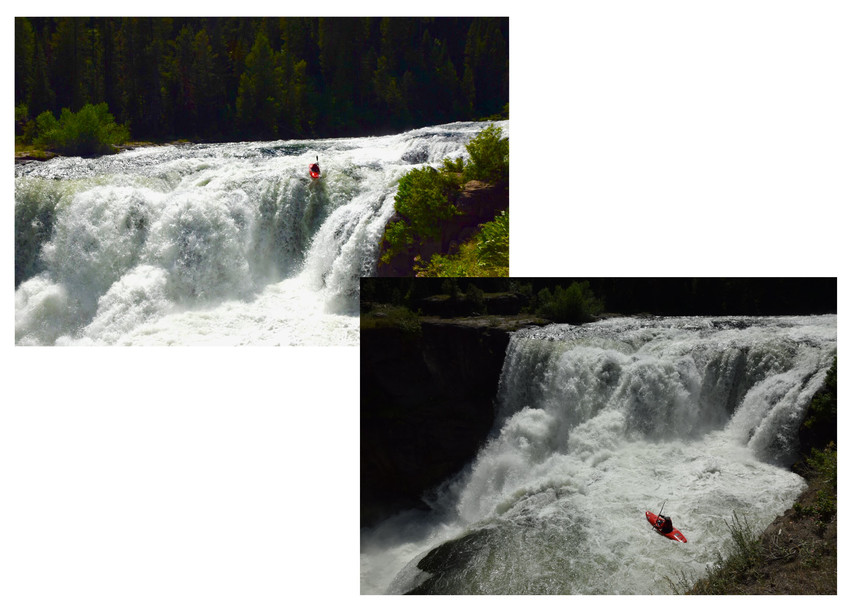 Running the middle and bottom drops on Lower Mesa Falls. Bruce Bonich photo.
Running the middle and bottom drops on Lower Mesa Falls. Bruce Bonich photo.
How did Alerces go?
RH: Alerces Falls is pretty interesting, it’s on the Rio Manso in Nahuel Huapi National Park. It’s this big sixty-foot waterfall, we ran it right around five am, at day break, because it’s illegal to run inside the National Park and we had to do it early. It went okay, I was the second in the group to paddle it, the first person went off. It’s a super high volume river, so you’re talking ten to twenty thousand CFS (cubic feet per second), just a ton of water. It’s this folding drop, there’s water coming from the right side and the left side, the way the lip was formed, there’s two cliffs on either side. The water hits it and it just folds. You have a ton of water going in the same spot and it creates a good pocket to go deep. The entire week of paddling in Chile was an incredible experience. Alerces was in the back of my mind, I had watched a lot of Bomb Flow videos and Substantial Media House videos of it and had an idea of what the waterfall looked like. Call it research if you want to, like just really trying to understand it. I was never even really that scared. We looked at it, it looked big, but smaller than I’d imagined. The entire week leading up to it I just thought, it’s a left stroke off the lip, wait no-- it’s a right stroke off the lip. I knew that I wanted to get my paddle away from my face and not blow up. I took a right stroke and got my paddle to the side… I don’t really know what happened, I think I fell on my head, flipped over in mid air. I felt the water, but it was so much water, so much aeration that it really didn’t hurt or anything although it was a little violent in the washing machine. Then, I felt a moment of calmness and a lot of kayakers know that those windows are when you do your roll and it’s a second nature to feel that in the water. So, I rolled up, caught the eddy, and watched my other two friends behind me run it. I wanted that move so bad, I didn’t care if I landed on my head, I just didn’t want to eat carbon shaft.
My first ever swim was off Sunset Falls on the East Fork of the Lewis, and I punched myself in the face and gave myself a black eye. Not recommended.
The first time we ran lower Mesa, my friend went first, and he hit his paddle across his mouth and broke the bone in his gum. We didn’t learn that until later. He broke his gum, and I saw him carp a roll, and then he finally rolled up and was all covered in blood, and he was down at the bottom alone. So, I was like “I think I can do a better job than that” and someone’s gotta get to him, so then I ran it. We walked out, we had a pretty sweet motorbike we’d set for shuttle but someone had inflated the tire too much and left it in the sun and it exploded, and it was the day before we were starting our Junior year of high school and we didn’t tell our parents we were running Mesa that day and we had to hitchhike twelve miles back up to our car to run shuttle, come back, and I didn’t get home till 10:30 that night and my parents were so pissed. My buddy went to the hospital the next day and had to have his mouth wired shut for two weeks cause he just ate his paddle.
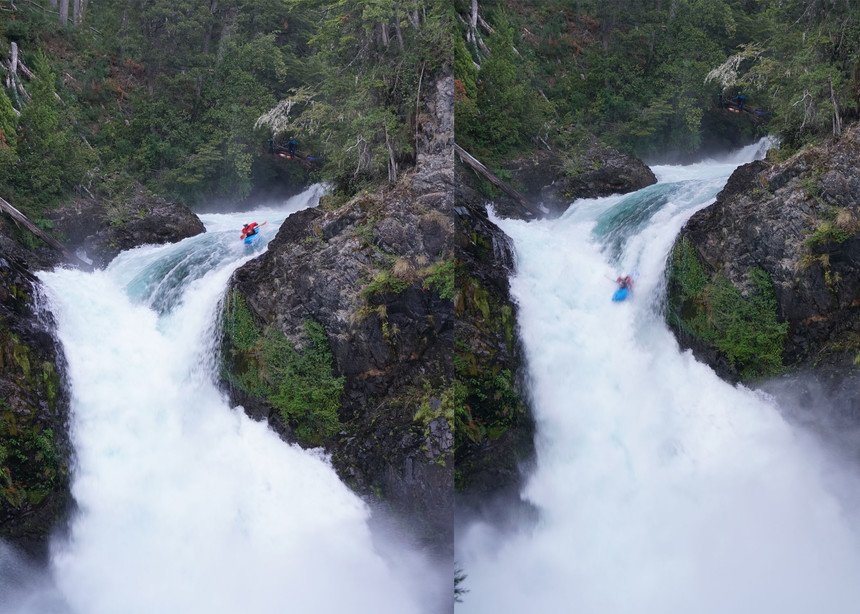 Alerces Falls in Patagonia. Laura Jiminez photo.
Alerces Falls in Patagonia. Laura Jiminez photo.
Looking at those classic PNW drops that preceded the running of Rattlesnake, what factors would you consider on those as someone who coaches and teaches decision making?
RH: I always kind of split it up into two categories- risk and danger. Danger’s a constant, right? There’s objective dangers in every sport you do that are just inherent, they’re not gonna change. You can’t change how dangerous something is. Like jumping off a hundred and twenty foot waterfall? It’s just dangerous, I’m not gonna argue that with anybody. Risk though, the reason we’re able to do these sports and the reason why the athletes are so impressive as they are, is because they handle, manage, and calculate risk unbelievably well. Risk can change. So, if you put a two-year-old baby in a kayak and pushed it off a hundred and twenty foot waterfall, that’s not only dangerous, it’s risky. There’s so much risk that you know that the outcome is what it’s gonna be-- it’s inevitable. But when you start to chip away at the risk of it, you start to make up a clear picture of how it can actually happen, how it can go well. So, in the case of Rattlesnake, you already have a location where everyone around you is a good kayaker. Galen and Hayden in particular are some of the best paddlers on the planet already. Just based on their experience, their attitude towards kayaking, what they want to achieve as professionals, who they’re with, what they already know, how they already do things, they’re already eliminating a ton of risk. You add that in with choosing the right friends-- Tyler Bradt was there, he’s already one of the legends of waterfalling in general. They’ve created a team of like-minded individuals who understand that danger component, how to do evacuations, how to do rescues, who trust one another. When you surround yourself with that kind of positive environment and that kind of grouping, what seems overly dangerous or impossible starts to become more palatable. You have to assume a lot of risk, you can shave it away but that’s never gonna go away. You just have to have the right person to accept it, to understand how risky what they’re doing is and to just be okay with it. It’s something that I think a lot of the best extreme sports athletes have, it’s why they’re paid and in movies and stuff, cause the normal person can’t tap into that.
What about technical factors that would go into running a drop like that?
RH: The stars would have to align too. Rattlesnake falls hasn’t really been done because they needed a historic flood event in order to make it runnable. It’s kind of like when I ran Alerces-- being there with the right people at the right time. Flow, people, where you are, what gear you have, stuff like that. These guys are pros, they surround themselves with professional paddlers who know what they’re doing and have the gear and the mental resources of those around them and their past experiences and the physical resources of being in shape and knowing what to do with their body and how the impact might feel. There’s a lot of intention behind it, but a lot has to be lucky too.
I’m all about paddling hard stuff. As long as someone feels like they can do it and is confident in who they’re with and what they can do and their line, I’m one of the biggest enablers of-- or I hope to be one of the biggest enablers of, with the kids, with my friends-- I want to be on the shoreline with a throwbag, with medical experience and knowledge so that they can feel they can do that in that environment. And I have friends who would do it to me too.
 Setting safety. Laura Jiminez photo.
Setting safety. Laura Jiminez photo.
How do you see the future of the sport changing or growing with running big drops?
RH: I can’t help but think at some point there’s just drops that are too big. That’s the dangerous thing. Like a 200-footer is a 200-footer. There’s just the definition of that impact or that strain on the human body that in my mind is a hard barrier. Someone might try? Someone’s gonna get close? So the progression to me isn’t like seeing who can do the most dangerous thing, but it’s who can re-define the sport of kayaking. I’m seeing a lot of downriver freestyle right now that’s defining it, and that’s not anyone doing anything ultra scary or gnarly, but is adding character and flavor and personality to what would normally just be a standard wave train. A lot of the kayak designs that are coming out right now, like the half-slices, are enabling that behavior. No one’s making “the waterfall boat.” No one’s marketing like a chastity belt, locked in, indestructible, plugging kayak so that you can get off the couch and run Outlet. I don’t know if that’s the future, I don’t know if like a super tall waterfall is the future, but it’s for sure really creative downriver play and freestyle.
Chatting with Reed provided one big takeaway: for drops like Rattlesnake to happen, the stars really have to align. While the skills involved in running a big drop are that of a class V kayaker, the most important pieces have more to do with the conditions. Flow, or how much water is in the river is absolutely essential, as it usually is with paddling. Your crew also plays a huge role in what you’re running. When surrounded by paddlers you trust and that have the skills required for a run or a drop, a lot is possible. Lastly, as with so many sports, headspace is absolutely crucial. Knowing the risks and accepting them, as well as knowing your own limits and what a line requires of you can act as the ultimate factor in whether or not to run something. As always, if you don’t actually know what you’re doing out there, take a step back and find someone who can teach you those skills properly so you don’t punch yourself in the face on your first ever swim.
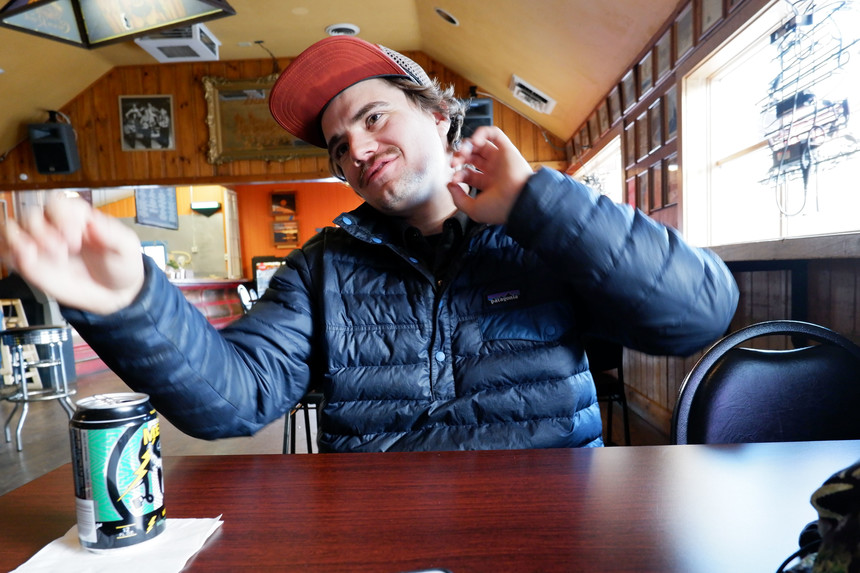 You can't describe a rapid without acting it
out- obviously. Izzy Lidsky photo.
You can't describe a rapid without acting it
out- obviously. Izzy Lidsky photo.
_________________________________________________________________________
As promised, a glossary:
Flow: how much water is in a river, as measured by CFS or cubic feet per second. Skiers check avy danger, kayakers check flows.
Class III, Class V: Rapids are rated on a scale of I-VI. Class I is moving water, Class V is one line, one line only, and if you mess it up, it’s gonna go poorly, and Class VI is considered unrunnable.
Creeking: a discipline of kayaking, where you’re running lower volume rivers with more technical features.
Playboating: freestyle kayaking or surfing, where the paddler stays stationary on one wave and surfs it.
Bow stall: a freestyle trick in which a kayaker stands his boat vertically up on the bow.
Rolling: flipping yourself back over in your kayak when you’re upside down.
Eddy-turn: eddys are created by rocks or bends in the river and are a tool kayakers use to navigate whitewater. Eddy turns are how you get out of an eddy.
Spray skirt: a super stylish piece of neoprene gear that you wear like a skirt and keeps you locked in your boat.
Boof: get your head out of the gutter… a boof stroke is a large stroke over the lip of a feature to launch yourself off it.
Going deep: Like when the snow keeps getting deeper, and your feelings keep getting deeper… but in water instead.
Carbon shaft: your head’s still in the gutter? Come on, that’s what we call the handle of your paddle.
Throwbag: a rope in a bag that’s used for rescue.
Half slice: a boat that has a lot of volume in the bow and not very much in the stern.



Jah Praise
March 1st, 2021
Nailed it Reed.
‘They’ve created a team of like-minded individuals who understand that danger component, how to do evacuations, how to do rescues, who trust one another. When you surround yourself with that kind of positive environment and that kind of grouping, what seems overly dangerous or impossible starts to become more palatable.’
Scott Sawyer
May 27th, 2021
This is what makes me excited and scared at the same time when talking about kayak riding in extreme rivers. The added uncontrollable makes it so different from other water sports. Thanks for sharing! Septic Pumping
Ralph2021
May 27th, 2021
Kayaking near waterfalls is absolutely dangerous if you’re a beginner and have no idea what you’re doing. But once you get the hang of it, the thrill is amazing and something you won’t get on other extreme sports. Thanks for sharing! Residential Roofing
TreePro
May 31st, 2021
I never knew how complex decision-making needs to be in the world of extreme kayaking. Thinking about it now it makes sense since it’s one of the most dangerous sports out there. Thanks for sharing! Emergency Tree Service
SamStevens
June 1st, 2021
I always knew that dangerous and extreme sports like this always involved proper logical thinking and decision-making. But seeing these interviews made me realize how deep it really is. Nice share! Septic Replacement